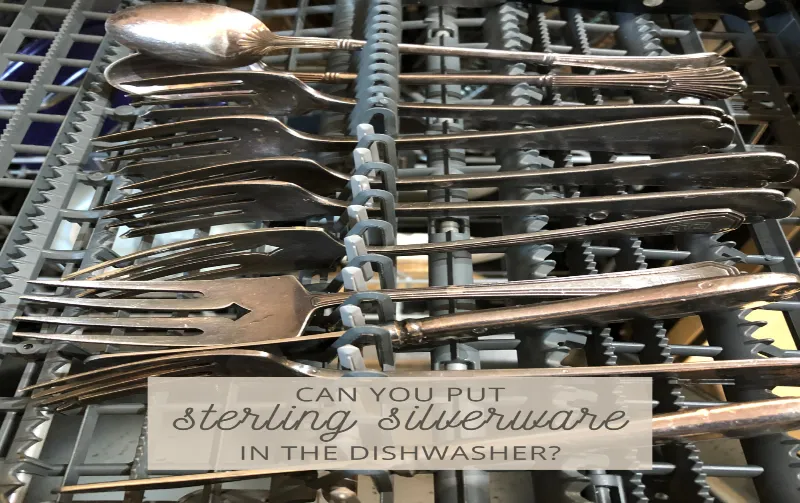Sterling silver should not go in the dishwasher. This practice can damage the metal over time.
Keeping your sterling silver shining requires proper care and maintenance.
Dishwashers, with their harsh detergents and high heat, can tarnish this precious metal and weaken its intricate patterns and designs.
For those who treasure their sterling silver flatware, hand washing with a soft cloth and gentle soap is the recommended cleaning method.
It’s crucial to dry silverware immediately after washing to prevent water spots and further tarnish.
With the right care, including storage in a tarnish-resistant cloth or container, your sterling silver can last for generations, adding elegance and sophistication to your dining experience.
Trusting time-honored techniques over modern conveniences preserves the beauty and value of your sterling silver investments.

Benefits Of Dishwashing Sterling Silver
Opting to use a dishwasher for cleaning sterling silver items provides both time-saving convenience and minimal manual labor.
Busy individuals can appreciate the efficiency with which a dishwasher tackles cleaning requirements, often achieving a more consistent result across all pieces.
The machine’s ability to handle intricate designs with ease means that every crevice and pattern is thoroughly cleaned, which can be challenging to accomplish by hand.
Drawbacks Of Dishwashing Sterling Silver
Sterling silver should never be placed in a dishwasher. The harsh environment inside the machine poses a significant risk of tarnishing or discoloration.
Chemical reactions between dishwasher detergent and the silver may lead to an undesirable change in color, often a dull yellowish tinge or even black spots, which are difficult to reverse.
Delicate components of sterling silver items can also sustain damage during the dishwashing cycle.
The force of water and vibration from the machine can lead to the loosening or complete detachment of these elements.
Moreover, exposure to high temperatures can distort the shape or weaken the structure of intricate designs.
| Dishwashing Concern | Explanation |
|---|---|
| Harmful Chemicals | The presence of harmful chemicals in detergents can exacerbate the deterioration of sterling silver. Such substances may accelerate corrosion, leaving fine silverware permanently damaged. |
Preparation Steps
Inspecting jewelry before placing it into the dishwasher is crucial.
Check for loose stones or clasp weaknesses to prevent possible damage during cleaning.
For the detergent, opt for a mild and non-abrasive type to protect the silver’s delicate surface.
As for organizing items, ensure sterling silver pieces are separated from stainless steel flatware to avoid a chemical reaction that could tarnish the silver.
Spread the silver items evenly on the dishwasher rack to avoid contact and potential scratches.
Dishwashing Process
Ensuring the longevity of sterling silver requires gentle care, making the dishwasher an unlikely candidate for cleaning.
Nonetheless, with certain precautions, it is possible to maintain its luster.
Opt for a gentle cycle with low heat to prevent damage from high temperatures and aggressive water flow.
It’s essential to avoid contact with other metals, as friction or chemical reactions could mar the silver’s surface.
Selecting eco-friendly detergents that lack harsh chemicals also contributes to preserving your silver’s shine.
These detergents prevent the unnecessary introduction of substances that could tarnish or erode the metal.
Despite these measures, it’s important to recognize that hand washing is often more suitable for maintaining the delicate nature of sterling silver.
Handwashing Techniques
Cleaning sterling silver should be approached with gentle care to maintain its luster and integrity.
Utilize a soft-bristled brush and mild soap for effective yet safe cleaning.
The soft bristles ensure that the silver’s surface is not scratched during the cleaning process.
Post-cleaning, take a microfiber cloth to polish the sterling silver items.
This type of cloth is preferred due to its fine fibers, which provide a high shine without leaving any streaks or lint.
Finally, make sure to rinse the items with lukewarm water.
It’s imperative to avoid extreme temperatures as they can cause damage or lead to premature tarnishing of sterling silver.
Professional Cleaning Services
Consulting with experienced jewelers is essential for preserving the beauty and longevity of your sterling silver items.
They can provide expert advice on the most effective cleaning techniques.
For intricate pieces, ultrasonic cleaning technology is often recommended, which uses high-frequency sound waves to remove dirt and grime without scratching the silver.
Jewelers also have access to specialized jewelry cleaning solutions, tailored to protect and restore the luster of sterling silver without the risks associated with dishwashers.
Frequently Asked Questions On Can Sterling Silver Go In The Dishwasher
Is Sterling Silver Dishwasher Safe?
Sterling silver should not be washed in the dishwasher. The harsh detergents and heat can cause tarnishing and damage.
Can Dishwashing Detergents Harm Sterling Silver?
Dishwashing detergents contain chemicals that can lead to corrosion and tarnishing of sterling silver items.
What Precautions Protect Silverware In Dishwashers?
To protect silverware, hand wash it instead, using a mild detergent and warm water, then dry immediately.
Does Dishwasher Cleaning Affect Silver Value?
Regularly exposing sterling silver to dishwasher cleaning can deteriorate its quality and lower its value over time.
Conclusion
To sum up, it’s best to avoid placing sterling silver in the dishwasher.
Hand washing preserves its luster, preventing damage from harsh detergents and heat.
Remember, your silverware’s longevity depends on proper care.
Keep these tips in mind to maintain the shine and integrity of your precious pieces for years to come.
